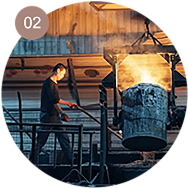
Effective Ways to Clean and Maintain Your Cast Iron Skillet for Longevity
Cleaning a Cast Iron Skillet A Comprehensive Guide
Cast iron skillets are cherished by many for their durability, heat retention, and ability to develop a natural non-stick surface over time. However, maintaining a cast iron skillet requires proper cleaning and seasoning techniques to ensure it lasts for generations. In this article, we will discuss effective methods for cleaning a cast iron skillet, as well as the best practices to keep it in pristine condition.
Why Proper Cleaning Is Essential
Unlike other cookware, cast iron skillets need special care to prevent rusting and maintain their non-stick surface. Improper cleaning can lead to food residue build-up, which affects both the flavor of meals and the skillet's performance. Moreover, neglecting to oil and season your skillet after cleaning can result in a dull appearance and increased susceptibility to rust.
Basic Cleaning Methods
1. The Simple Hot Water Rinse
For most everyday cooking tasks where you haven't cooked overly greasy or sticky foods, simply rinsing your skillet with hot water is sufficient. After using the skillet, allow it to cool slightly but not completely. Pour hot water into the pan and use a non-abrasive sponge or brush to scrub away any leftover food particles. Avoid soap, as it can strip the skillet of its natural seasoning.
2. The Salt Scrub
For tougher residues, especially after frying or baking, a salt scrub can be very effective. While the skillet is still warm, sprinkle a generous amount of coarse kosher salt onto the surface. Using a cloth or paper towel, rub the salt into the skillet in circular motions. The salt acts as an abrasive, helping to scrub away stubborn bits without damaging the seasoned surface. Rinse the skillet with hot water afterward.
cleaning cast iron skillet

If your skillet has accumulated significant build-up or rust, a more aggressive approach may be necessary, such as using the oven to strip the pan. Preheat your oven to 350°F (175°C). Line a baking sheet with aluminum foil (to catch drips) and place the skillet upside down on the top rack. Bake for one hour, which will help loosen any stubborn residue. Afterward, turn off the oven and let the skillet cool inside before removing it.
Drying and Seasoning
After cleaning your cast iron skillet, it's vital to dry it completely to prevent rusting. The best method is to place the skillet on the stove over low heat for a few minutes until all the moisture evaporates. Once dry, you should re-season the skillet by applying a thin layer of vegetable oil, shortening, or flaxseed oil using a paper towel. Then, heat the skillet on the stove or in the oven at a high temperature for about 30 minutes. This process helps restore the non-stick layer and provides a protective barrier against moisture.
Avoid Common Mistakes
While cleaning your cast iron skillet, be mindful of some common pitfalls
- Avoid Soap While it's commonly believed that soap is a big no-no, it's worth mentioning that a small amount occasionally won't ruin your skillet. However, it’s best to stick with traditional methods. - No Soaking Don't soak your cast iron skillet in water. Prolonged exposure to moisture can lead to rusting.
- Skip the Dishwasher Always hand wash your skillet. Dishwashers are too harsh for cast iron.
Conclusion
Cleaning a cast iron skillet may seem daunting, but following these methods can help ensure your skillet remains an indispensable part of your kitchen for years to come. Just remember to clean it promptly after use, dry it thoroughly, and keep it seasoned. With proper care, your cast iron skillet will not only enhance your cooking but also become a treasured heirloom passed down through generations. Happy cooking!
-
Authentic Traditional Chinese Wok for High-Performance CookingNewsAug.02,2025
-
Season Cast Iron Perfectly with GPT-4 Turbo TipsNewsAug.01,2025
-
High Quality Cast Iron Cookware - Baixiang County Zhongda MachineryNewsAug.01,2025
-
Premium Cast Iron Pan: Durable & Perfect HeatNewsAug.01,2025
-
High Quality Kitchen Durable Black Round Cast Iron Cookware Pancake Crepe Pan-Baixiang County Zhongda Machinery Manufacturing Co., Ltd.NewsAug.01,2025
-
Cast Iron Cookware - Baixiang County Zhongda Machinery | Nonstick, Heat ResistanceNewsAug.01,2025


